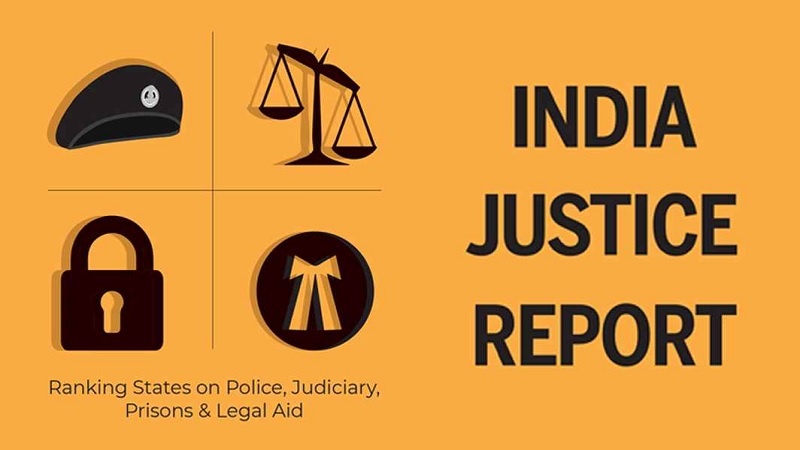Justice Report 2019: Where India stands on police, prisons, judiciary and legal aid
 Image Courtesy: indialegallive.com
Image Courtesy: indialegallive.com
The
recently released India Justice Report, 2019 – a comprehensive analysis
of individual Indian states and their performance on police, prisons,
judiciary and legal aid ranked West Bengal 12th among the 18 large states surveyed and 4th for prisons, while finding it at the bottom half of the list in legal aid, judiciary and the police.
The
report uses government data to understand the budgets, infrastructure,
human resources, workload, diversity and five year trends of police,
prisons, judiciary and legal aid, reported The Telegraph India.
Though
it is commendable that West Bengal has ranked first in parameters
pertaining to improvement in all categories, it is analysed in the
report that West Bengal has a vacancy of nearly 50 percent in the
judiciary and more than 25 percent posts waiting to be filled for the
police staff. Also, the report says that the budgetary allocations for
prisons and judiciary have not increased with the corresponding
increases in the general state expenditure between 2012 and 2016. If
this continues, the upward trend in improvement may witness a slowdown.
With
regards to policing, there was a 42 percent vacancy in the number of
scheduled caste officers, 55 percent vacancy in scheduled tribe officers
and a shocking 82 percent vacancy in Other Backward Classes (OBC)
officers. Women accounted for less than 10 percent of the total staff
strength and according to experts it would take the state 29 years to
get to the number of having 33 percent of women in the workforce.
The
state also sees a vacancy of 75 percent and 85 percent among medical
staff and medical officers placed in correctional homes respectively.
With
regards to judiciary, the increase in number of vacancies in the West
Bengal High court and subordinate courts is a cause for worry. It is
quite shocking that the state’s per capita spend in judiciary was the
lowest in 2015 – 16, even though the population per high court judge was
among the highest. However, a statistic that emerged as a silver lining
that the Calcutta High Court was among a handful of courts with a case
clearance rate of over 100 percent. Also, though 32.1 percent of the
ongoing cases in subordinate courts have been pending for five years or
more, case clearance rate there is over 90 percent.
With
regards to legal aid, the report said that 83 percent of the districts
were within the coverage of the district legal services authorities
(DLSAs). The DLSAs are the bodies entrusted with providing free legal
aid in the districts. The report states that in Bengal, paralegal
volunteers who act as the bridge between the people and the legal aid
system, are present in the strength of two for every one lakh persons.
While Bengal does well on most parameters of this pillar,
underutilization of funds from the National Legal Services Authority and
the state’s share in legal aid spending seem to have kept it from
climbing high in the rankings.
In
the same vein, Kerala which was rated best for its prisons and legal
aid and fifth for judiciary, it was ranked fifth from the bottom for its
police capacity. Till January 2017, only 6.3 percent of Kerala’s police
personnel were women. At its current rate of growth, it would take
Kerala 30 years to reach the recommended 33% figure of women in the
police force.
However,
contrary to the claims of the Uttar Pradesh and Bihar governments, the
two states have ranked at the bottom at almost every parameter. UP
received a score of 2.98 on policing, while Bihar received a score of
3.77 for the same.
With
regards to prisons, marked on various factors ranging from overcrowding
to budgeting and infrastructure, Bihar stood at number 6 out of 18
states with a score of 5.61 while UP scored 4.42.
On
the parameters of judiciary – availability of judges, clearance of
cases and the budget spend on judiciary, Bihar fared the worst with a
score of 2.41 followed by UP which scored 3.7.
Maharashtra fared the best on all parameters.
However,
the numbers that the report shows are far from ideal. They portray the
government lackadaisical approach in tackling vacancies and not taking
concrete steps to upgrade the outdated legal framework and
infrastructure. It also highlights the stark need for gender
sensitization to assure that the justice system reflects the diversity
that is needed.
It
is also imperative that the judiciary itself take stock of pendency in
appointments of judges instead of blaming the Centre for not giving
attention to collegium recommendations. The Financial Express
reported that the bigger problem was with the higher judiciary dragging
its feet on appointments. Given it took the government 127 days to run
background checks on judges, as the attorney general pointed out in the
SC, it is hard to understand why it took the SC 119 days on average to
decide on appointments after receiving the recommendations of the
various High Court collegia forwarded by the law ministry. Shockingly,
in the case of 199 vacancies out of 396 (as on February 1) in the High
Courts, the High Court collegia hadn’t even forwarded names; in the case
of some High Courts, recommendations had not been received for five
years after the vacancies arose!
The
India Justice Report 2019 recommends that the states undertake a cost –
benefit analysis that justifies the increasing human resources costs
against the failure to address crime and judicial delay. It also
recommended that the states pay attention to the recruitment of women,
religious minorities and the marginalized communities and improve
transparency in the justice system with periodic research and collection
of data

No comments:
Post a Comment